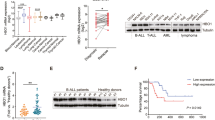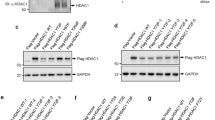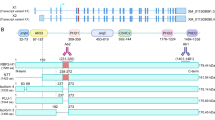Abstract
The t(1;19) translocation in pediatric pre-B-cell acute lymphoblastic leukemia (ALL) fuses the genes, which encode the transcriptional activator E2A and homeobox pre-B-cell leukemia transcription factor 1 (PBX1), resulting in expression of the chimeric transcription factor E2A-PBX1. E2A-PBX1 can promote cell transformation both in vitro and in vivo; however, the mechanisms by which E2A-PBX1 contributes to malignancy merit further investigation. In the current work we report, for the first time, a physical and functional interaction between the SPT3-TAFII31-GCN5L acetylase (STAGA) complex and E2A-PBX1. STAGA, and its acetyltransferase subunit GCN5, directly interacted with the E2A portion of E2A-PBX1. GCN5 acetylated E2A-PBX1 and increased the stability of E2A-PBX1 protein in cells. Moreover, the GCN5 inhibitor α-methylene-γ-butyrolactone 3 (MB-3) decreased E2A-PBX1 acetylation and E2A-PBX1 protein levels in leukemic cells, indicating that GCN5 inhibitors have potential value as therapeutic agents for ALL. In addition, we show that the E3 ubiquitin ligase HDM2 potentiates the degradation of E2A-PBX1. We suggest that dynamic regulation of E2A-PBX1 protein levels in vivo has a fundamental role in ALL.
This is a preview of subscription content, access via your institution
Access options
Subscribe to this journal
Receive 12 print issues and online access
$259.00 per year
only $21.58 per issue
Buy this article
- Purchase on Springer Link
- Instant access to full article PDF
Prices may be subject to local taxes which are calculated during checkout





Similar content being viewed by others
References
Esparza SD, Sakamoto KM . Topics in pediatric leukemia--acute lymphoblastic leukemia. MedGenMed 2005; 7: 23.
Carroll AJ, Crist WM, Parmley RT, Roper M, Cooper MD, Finley WH . Pre-B cell leukemia associated with chromosome translocation 1;19. Blood 1984; 63: 721–724.
Aspland SE, Bendall HH, Murre C . The role of E2A-PBX1 in leukemogenesis. Oncogene 2001; 20: 5708–5717.
Secker-Walker LM, Berger R, Fenaux P, Lai JL, Nelken B, Garson M et al. Prognostic significance of the balanced t(1;19) and unbalanced der(19)t(1;19) translocations in acute lymphoblastic leukemia. Leukemia 1992; 6: 363–369.
Bain G, Maandag EC, Izon DJ, Amsen D, Kruisbeek AM, Weintraub BC et al. E2A proteins are required for proper B cell development and initiation of immunoglobulin gene rearrangements. Cell 1994; 79: 885–892.
Monica K, LeBrun DP, Dedera DA, Brown R, Cleary ML . Transformation properties of the E2a-Pbx1 chimeric oncoprotein: fusion with E2a is essential, but the Pbx1 homeodomain is dispensable. Mol Cell Biol 1994; 14: 8304–8314.
Chang CP, de Vivo I, Cleary ML . The Hox cooperativity motif of the chimeric oncoprotein E2a-Pbx1 is necessary and sufficient for oncogenesis. Mol Cell Biol 1997; 17: 81–88.
Knoepfler PS, Kamps MP . The highest affinity DNA element bound by Pbx complexes in t(1;19) leukemic cells fails to mediate cooperative DNA-binding or cooperative transactivation by E2a-Pbx1 and class I Hox proteins - evidence for selective targetting of E2a-Pbx1 to a subset of Pbx-recognition elements. Oncogene 1997; 14: 2521–2531.
Fu X, McGrath S, Pasillas M, Nakazawa S, Kamps MP . EB-1, a tyrosine kinase signal transduction gene, is transcriptionally activated in the t(1;19) subset of pre-B ALL, which express oncoprotein E2a-Pbx1. Oncogene 1999; 18: 4920–4929.
McWhirter JR, Neuteboom ST, Wancewicz EV, Monia BP, Downing JR, Murre C . Oncogenic homeodomain transcription factor E2A-Pbx1 activates a novel WNT gene in pre-B acute lymphoblastoid leukemia. Proc Natl Acad Sci USA 1999; 96: 11464–11469.
Nagy Z, Tora L . Distinct GCN5/PCAF-containing complexes function as co-activators and are involved in transcription factor and global histone acetylation. Oncogene 2007; 26: 5341–5357.
Martinez E, Palhan VB, Tjernberg A, Lymar ES, Gamper AM, Kundu TK et al. Human STAGA complex is a chromatin-acetylating transcription coactivator that interacts with pre-mRNA splicing and DNA damage-binding factors in vivo. Mol Cell Biol 2001; 21: 6782–6795.
Lee KK, Workman JL . Histone acetyltransferase complexes: one size doesn’t fit all. Nat Rev Mol Cell Biol 2007; 8: 284–295.
Grant PA, Duggan L, Cote J, Roberts SM, Brownell JE, Candau R et al. Yeast Gcn5 functions in two multisubunit complexes to acetylate nucleosomal histones: characterization of an Ada complex and the SAGA (Spt/Ada) complex. Genes Dev 1997; 11: 1640–1650.
Massari ME, Grant PA, Pray-Grant MG, Berger SL, Workman JL, Murre C . A conserved motif present in a class of helix-loop-helix proteins activates transcription by direct recruitment of the SAGA complex. Mol Cell 1999; 4: 63–73.
Scheele JS, Kolanczyk M, Gantert M, Zemojtel T, Dorn A, Sykes DB et al. The Spt-Ada-Gcn5-acetyltransferase complex interaction motif of E2a is essential for a subset of transcriptional and oncogenic properties of E2a-Pbx1. Leuk Lymphoma 2009; 50: 816–828.
Bradney C, Hjelmeland M, Komatsu Y, Yoshida M, Yao TP, Zhuang Y . Regulation of E2A activities by histone acetyltransferases in B lymphocyte development. J Biol Chem 2003; 278: 2370–2376.
Hyndman BD, Thompson P, Denis CM, Chitayat S, Bayly R, Smith SP et al. Mapping acetylation sites in E2A identifies a conserved lysine residue in activation domain 1 that promotes CBP/p300 recruitment and transcriptional activation. Biochem Biophys Acta 2012; 1819: 375–381.
Bayly R, Chuen L, Currie RA, Hyndman BD, Casselman R, Blobel GA et al. E2A-PBX1 interacts directly with the KIX domain of CBP/p300 in the induction of proliferation in primary hematopoietic cells. J Biol Chem 2004; 279: 55362–55371.
Bayly R, Murase T, Hyndman BD, Savage R, Nurmohamed S, Munro K et al. Critical role for a single leucine residue in leukemia induction by E2A-PBX1. Mol Cell Biol 2006; 26: 6442–6452.
Hyndman BD, Thompson P, Bayly R, Cote GP, Lebrun DP . E2A proteins enhance the histone acetyltransferase activity of the transcriptional co-activators CBP and p300. Biochem Biophys Acta 2012; 1819: 446–453.
Caron C, Boyault C, Khochbin S . Regulatory cross-talk between lysine acetylation and ubiquitination: role in the control of protein stability. Bioessays 2005; 27: 408–415.
Fang S, Jensen JP, Ludwig RL, Vousden KH, Weissman AM . Mdm2 is a RING finger-dependent ubiquitin protein ligase for itself and p53. J Biol Chem 2000; 275: 8945–8951.
Swerdlow SH, Campo E, Lee Harris N, Jaffe ES, Pileri SA, Stein H et al WHO Classification of Tumours of Haematopoietic and Lymphatic Tissues. The International Agency for Research on Cancer, IARC: Lyon, 2008.
Bjorklund E, Mazur J, Soderhall S, Porwit-MacDonald A . Flow cytometric follow-up of minimal residual disease in bone marrow gives prognostic information in children with acute lymphoblastic leukemia. Leukemia 2003; 17: 138–148.
Wallberg AE, Yamamura S, Malik S, Spiegelman BM, Roeder RG . Coordination of p300-mediated chromatin remodeling and TRAP/mediator function through coactivator PGC-1alpha. Mol Cell 2003; 12: 1137–1149.
Kamps MP, Look AT, Baltimore D . The human t(1;19) translocation in pre-B ALL produces multiple nuclear E2A-Pbx1 fusion proteins with differing transforming potentials. Genes Dev 1991; 5: 358–368.
Biel M, Kretsovali A, Karatzali E, Papamatheakis J, Giannis A . Design, synthesis, and biological evaluation of a small-molecule inhibitor of the histone acetyltransferase Gcn5. Angew Chem Int Ed Engl 2004; 43: 3974–3976.
Mai A, Rotili D, Tarantino D, Ornaghi P, Tosi F, Vicidomini C et al. Small-molecule inhibitors of histone acetyltransferase activity: identification and biological properties. J Med Chem 2006; 49: 6897–6907.
Herrera JE, Bergel M, Yang XJ, Nakatani Y, Bustin M . The histone acetyltransferase activity of human GCN5 and PCAF is stabilized by coenzymes. J Biol Chem 1997; 272: 27253–27258.
Santos-Rosa H, Valls E, Kouzarides T, Martinez-Balbas M . Mechanisms of P/CAF auto-acetylation. Nucleic Acids Res 2003; 31: 4285–4292.
Thompson PR, Wang D, Wang L, Fulco M, Pediconi N, Zhang D et al. Regulation of the p300 HAT domain via a novel activation loop. Nat Struct Mol Biol 2004; 11: 308–315.
Hansson ML, Popko-Scibor AE, Saint Just Ribeiro M, Dancy BM, Lindberg MJ, Cole PA et al. The transcriptional coactivator MAML1 regulates p300 autoacetylation and HAT activity. Nucleic Acids Res 2009; 37: 2996–3006.
Bertino EM, Otterson GA . Romidepsin: a novel histone deacetylase inhibitor for cancer. Expert Opin Investig Drugs 2011; 20: 1151–1158.
Grant S, Easley C, Kirkpatrick P . Vorinostat. Nat Rev Drug Discov 2007; 6: 21–22.
Manzo F, Tambaro FP, Mai A, Altucci L . Histone acetyltransferase inhibitors and preclinical studies. Expert Opin Ther Pat 2009; 19: 761–774.
Acknowledgements
The authors thank Dr DP LeBrun, Dr FB Hillgarter, Dr P Puigserver, Dr PA Cole and Dr D Bohmann for generously providing expression plasmids described in Materials and methods. Dr RG Roeder is acknowledged for the kind gifts of antibodies and the fh:SPT3 stable cell line. Dr K Pokrovskaja and A-C Bjorklund are gratefully acknowledged for technical assistance with primary ALL cell culture. This work was supported by grants from the Swedish Research Council, Swedish Cancer Society, the Swedish Children’s Cancer Foundation and Radiumhemmets forskningsfonder. MJL was supported by a fellowship from the Swedish Children’s Cancer Foundation.
Author information
Authors and Affiliations
Corresponding author
Ethics declarations
Competing interests
The authors declare no conflict of interest.
Rights and permissions
About this article
Cite this article
Holmlund, T., Lindberg, M., Grander, D. et al. GCN5 acetylates and regulates the stability of the oncoprotein E2A-PBX1 in acute lymphoblastic leukemia. Leukemia 27, 578–585 (2013). https://doi.org/10.1038/leu.2012.265
Received:
Revised:
Accepted:
Published:
Issue Date:
DOI: https://doi.org/10.1038/leu.2012.265
Keywords
This article is cited by
-
The advances of E2A-PBX1 fusion in B-cell acute lymphoblastic Leukaemia
Annals of Hematology (2023)
-
GCN5-mediated regulation of pathological cardiac hypertrophy via activation of the TAK1-JNK/p38 signaling pathway
Cell Death & Disease (2022)
-
The impact of CBP expression in estrogen receptor-positive breast cancer
Clinical Epigenetics (2021)
-
Transcription factor 4 and its association with psychiatric disorders
Translational Psychiatry (2021)
-
Molecular processes involved in B cell acute lymphoblastic leukaemia
Cellular and Molecular Life Sciences (2018)



